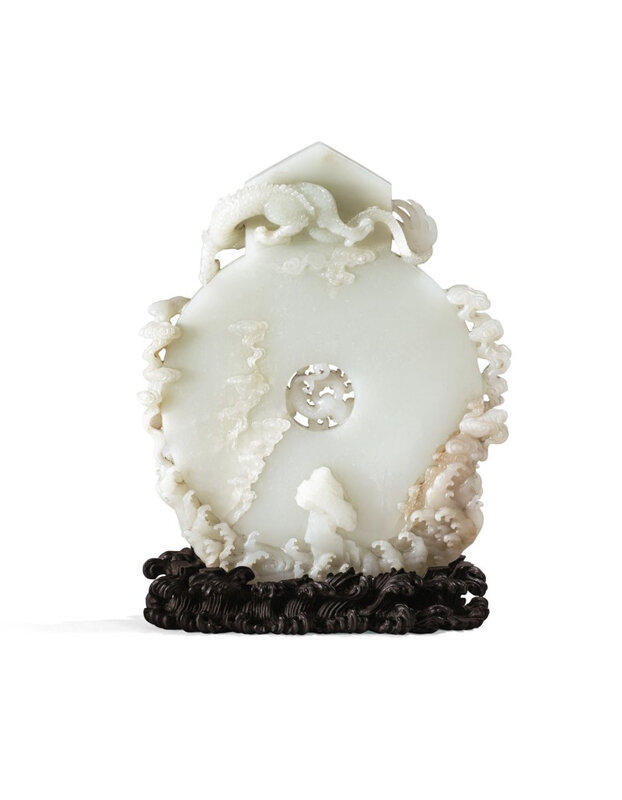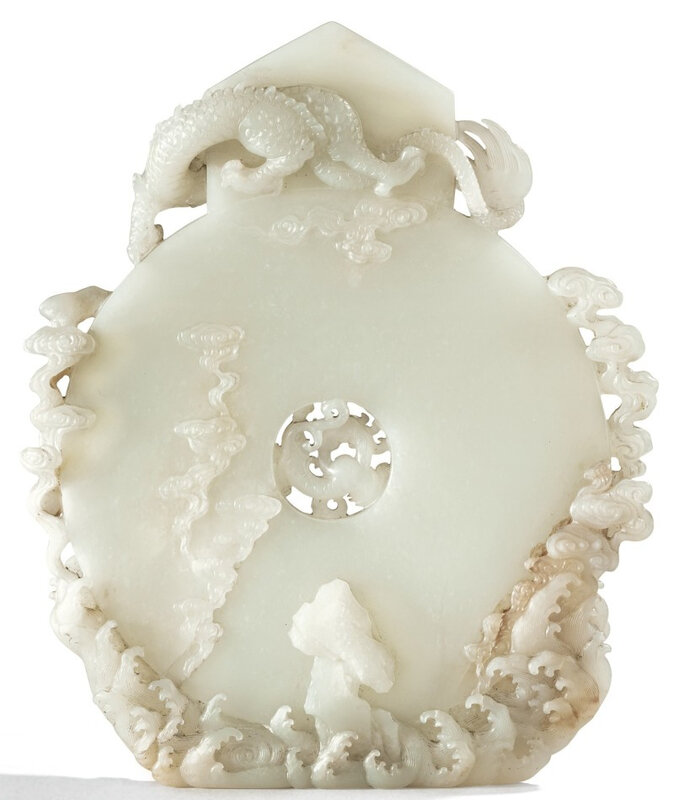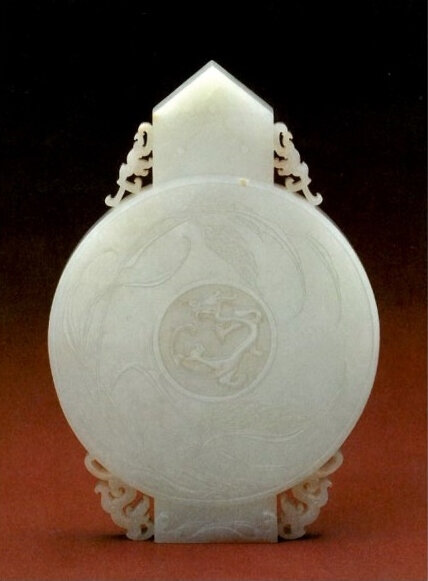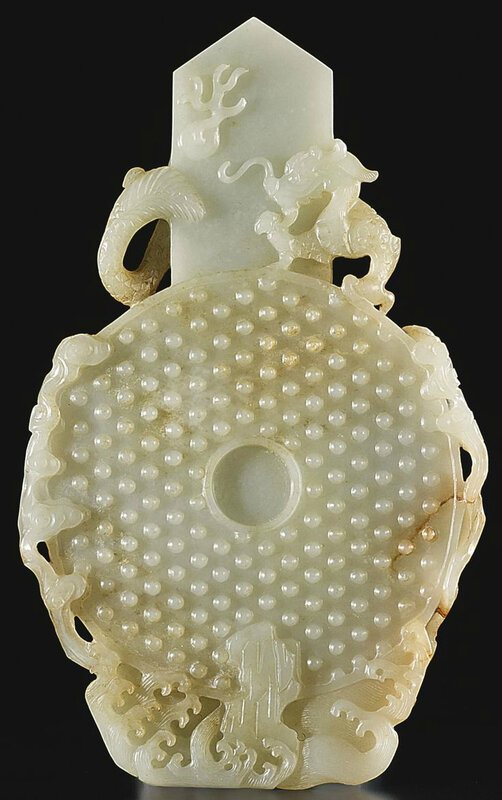A very rare archaistic pale celadon jade disc, guibi, Qing Dynasty, Qianlong period (1736-1795)
Lot 59. A very rare archaistic pale celadon jade disc, guibi, Qing Dynasty, Qianlong period (1736-1795); 19,8 cm, 7¾ in. Estimate: 40,000 - 60,000 EUR. Lot sold: 492,500 EUR. © Sotheby's.
en forme de sceptre gui combiné à un disque bi émergeant de flots tumultueux et de rochers en partie inférieure, le fin disque bi enchâssé dans des nuées en forme de ruyi sur les côtés, chaque face sculptée de quelques nuées en forme de ruyi épousant les veines naturelles de la pierre, la partie sommitale du gui entourée d’un puissant dragon sinueux et aux fines écailles pourchassant la perle enflammée, l'intérieur du bi ajouré d'un dragon sinueux, la pierre au doux poli et d’une couleur blanche uniforme, socle sculpté de flots tumultueux.
Note: This rare jade disc combines two of the most recognisable objects made in early Chinese jade history. The disc (bi) and the tablet (gui) both appear among the six important ritual jades in the Zhouli (Rites of Zhou), one of the three classics on rites and etiquette compiled in the latter part of the Eastern Zhou dynasty. It lists the six ritual jades as bi, cong, gui, zhang, hu and huang. Their functions and forms were later reconstructed by Nie Chongyi in the Sanli tu (Three Rituals Illustrated) during the Northern Song Dynasty, and by Wu Dacheng in his Guyu tukao (Investigations of Ancient Jade with Illustrations) in the late Qing Dynasty.
While jade discs bi appeared in burials of the Neolithic period, their round shape was believed to represent the shape of heaven while also serving as a symbol of rank and wealth found in high-ranking burials as early as in Hongshan and Liangzhu cultures and as late as the Western Han period. The jade tablet gui with is pointed tip did not appear before the late Eastern Zhou period and was similarly associated as symbols of rank.
A concern with China's past that began in the Northern Song dynasty and the reassessment of that past after the fall of the northern capital saw a renewed interest in ancient practices and values as well as the material past, documented in printed books. Their impact on material culture from the Song dynasty onwards contributed to the revival and dissemination of ancient shapes and designs. The Guyu tupu, compiled in 1176 by imperial commission, is the among the first such books on ancient jades to illustrate a guibi, a disc combined with appointed blade, compare Guyu tupu, sanshi er juan, juan 2, pp. 12 and 13. A Ming dynasty jade disc combined with a tablet in the collection of the British Museum, London, closely follows the printed example in its form and design. Jessica Rawson notes that ‘although no such combination of disc and pointed blade had existed, the attempt at the combination and careful rendering of the surface ornament indicate concern, if displaced, for historical accuracy’, see Jessica Rawson, Chinese Jade from the Neolithic to the Qing, London, 1995, pp. 91 and 92, fig. 88.
Like the previous lot, this rare jade disc shows some unique features that adhere more to 18th century style and preferences than to an earlier model such as a small jade guibi in the Palace Museum Collection, illustrated in Compendium of Collections in the Palace Museum, Jade, Vol. 6, Ming Dynasty, Hefei, 2011, p. 28, col. pl. 5. The disc emerges from a bed of tumultuous waves and is enveloped by dense scrolling clouds. A sinuous dragon circles the pointed tip of the tablet, a much smaller dragon occupies the central aperture of the disc. This specific design may have been inspired by Western Han jade discs such as found in the tomb of the King of Nan Yue in Guangzhou, compare, for instance, jade discs from this tomb published in Jades from the Tomb of the King of Nanyue, Guangzhou, 1991, pls. 40, 42 and 53. We know that a Western Han jade disc with dragons was in the imperial collection as one such disc was illustrated on the Guwantu.
Among the rare comparable examples is a jade guibi in the Palace Museum Collection in Beijing, illustrated in The Complete Collection of Treasures of the Palace Museum. Jadeware (III), Hong Kong, 1995, p. 160, no. 129 (Fig. 1). Another jade guibi dated to the 19th century, was sold in Sotheby's New York, 15th and 16th September 2015, lot 200 (Fig 2).
A white jade disc, guibi, from The Palace Museum, Beijing, illustrated in The Complete Collection of Treasures of the Palace Museum. Jadeware (III), Hong Kong, 1995, p. 160, no. 129.
An archaistic pale celadon jade 'Twelve symbols' tablet, Qing dynasty, 19th century. Height 9 1/4 in., 23.5 cm. Sold for 150,000 USD at Sotheby's New York, 15th and 16th September 2015, lot 200. © Sotheby's.
Cf. my post: An archaistic pale celadon jade 'Twelve symbols' tablet, Qing dynasty, 19th century
Sotheby's. Arts d'Asie, Paris, 10 december 2019.

/https%3A%2F%2Fprofilepics.canalblog.com%2Fprofilepics%2F1%2F0%2F100183.jpg)
/https%3A%2F%2Fstorage.canalblog.com%2F03%2F02%2F119589%2F96711876_o.jpg)
/https%3A%2F%2Fstorage.canalblog.com%2F11%2F31%2F119589%2F94773502_o.jpg)
/https%3A%2F%2Fstorage.canalblog.com%2F20%2F83%2F119589%2F94772815_o.jpg)
/https%3A%2F%2Fstorage.canalblog.com%2F26%2F72%2F119589%2F75604929_o.jpg)
/https%3A%2F%2Fstorage.canalblog.com%2F59%2F60%2F119589%2F26458628_o.jpg)









/image%2F1371349%2F20240426%2Fob_0d4ec9_telechargement-27.jpg)
/image%2F1371349%2F20240426%2Fob_b8573a_telechargement-15.jpg)
/image%2F1371349%2F20240423%2Fob_af8bb4_telechargement-6.jpg)
/image%2F1371349%2F20240423%2Fob_b6c4a6_telechargement.jpg)